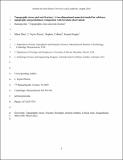| dc.contributor.author | Perron, J. Taylor | |
| dc.contributor.author | Martel, Stephen J. | |
| dc.contributor.author | Singha, Kamini | |
| dc.contributor.author | Slim, Mirna I. | |
| dc.date.accessioned | 2015-07-28T14:02:47Z | |
| dc.date.available | 2015-07-28T14:02:47Z | |
| dc.date.issued | 2014-09 | |
| dc.date.submitted | 2014-07 | |
| dc.identifier.issn | 01979337 | |
| dc.identifier.issn | 1096-9837 | |
| dc.identifier.uri | http://hdl.handle.net/1721.1/97898 | |
| dc.description.abstract | Theoretical calculations indicate that elastic stresses induced by surface topography may be large enough in some landscapes to fracture rocks, which in turn could influence slope stability, erosion rates, and bedrock hydrologic properties. These calculations typically have involved idealized topographic profiles, with few direct comparisons of predicted topographic stresses and observed fractures at specific field sites. We use a numerical model to calculate the stresses induced by measured topographic profiles and compare the calculated stress field with fractures observed in shallow boreholes. The model uses a boundary element method to calculate the stress distribution beneath an arbitrary topographic profile in the presence of ambient tectonic stress. When applied to a topographic profile across the Susquehanna Shale Hills Critical Zone Observatory in central Pennsylvania, the model predicts where shear fractures would occur based on a Mohr–Coulomb criterion, with considerable differences in profiles of stresses with depth beneath ridgetops and valley floors. We calculate the minimum cohesion required to prevent shear failure, C[subscript min], as a proxy for the potential for fracturing or reactivation of existing fractures. We compare depth profiles of C[subscript min] with structural analyses of image logs from four boreholes located on the valley floor, and find that fracture abundance declines sharply with depth in the uppermost 15 m of the bedrock, consistent with the modeled profile of C[subscript min]. In contrast, C[subscript min] increases with depth at comparable depths below ridgetops, suggesting that ridgetop fracture abundance patterns may differ if topographic stresses are indeed important. Thus, the present results are consistent with the hypothesis that topography can influence subsurface rock fracture patterns and provide a basis for further observational tests. | en_US |
| dc.description.sponsorship | United States. Army Research Office (Award W911NF-14-1-0037) | en_US |
| dc.description.sponsorship | United States. Dept. of Energy (Award DE-FG01-97ER14760) | en_US |
| dc.language.iso | en_US | |
| dc.publisher | Wiley Blackwell | en_US |
| dc.relation.isversionof | http://dx.doi.org/10.1002/esp.3646 | en_US |
| dc.rights | Creative Commons Attribution-Noncommercial-Share Alike | en_US |
| dc.rights.uri | http://creativecommons.org/licenses/by-nc-sa/4.0/ | en_US |
| dc.source | MIT web domain | en_US |
| dc.title | Topographic stress and rock fracture: a two-dimensional numerical model for arbitrary topography and preliminary comparison with borehole observations | en_US |
| dc.type | Article | en_US |
| dc.identifier.citation | Slim, Mirna, J. Taylor Perron, Stephen J. Martel, and Kamini Singha. “Topographic Stress and Rock Fracture: a Two-Dimensional Numerical Model for Arbitrary Topography and Preliminary Comparison with Borehole Observations.” Earth Surface Processes and Landforms 40, no. 4 (September 18, 2014): 512–529. | en_US |
| dc.contributor.department | Massachusetts Institute of Technology. Department of Earth, Atmospheric, and Planetary Sciences | en_US |
| dc.contributor.mitauthor | Slim, Mirna I. | en_US |
| dc.contributor.mitauthor | Perron, J. Taylor | en_US |
| dc.relation.journal | Earth Surface Processes and Landforms | en_US |
| dc.eprint.version | Author's final manuscript | en_US |
| dc.type.uri | http://purl.org/eprint/type/JournalArticle | en_US |
| eprint.status | http://purl.org/eprint/status/PeerReviewed | en_US |
| dspace.orderedauthors | Slim, Mirna; Perron, J. Taylor; Martel, Stephen J.; Singha, Kamini | en_US |
| dc.identifier.orcid | https://orcid.org/0000-0002-0404-8701 | |
| dc.identifier.orcid | https://orcid.org/0000-0002-2646-7384 | |
| mit.license | OPEN_ACCESS_POLICY | en_US |
| mit.metadata.status | Complete | |
